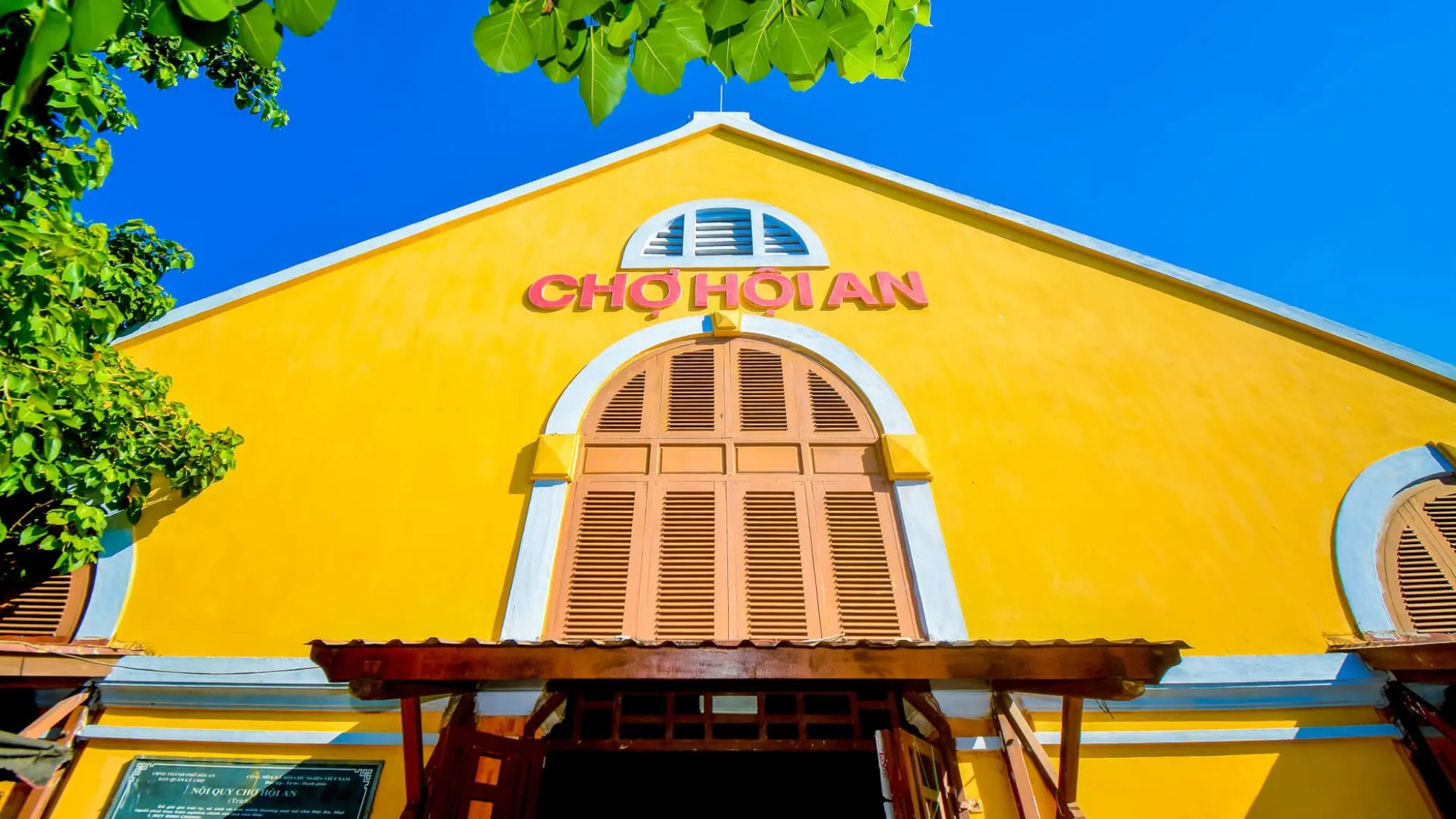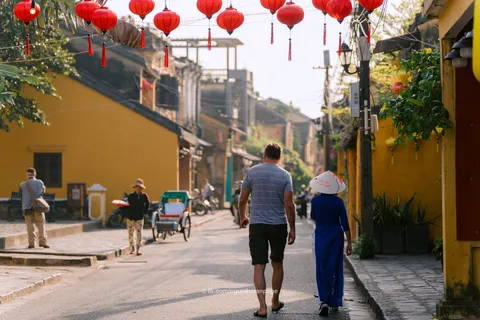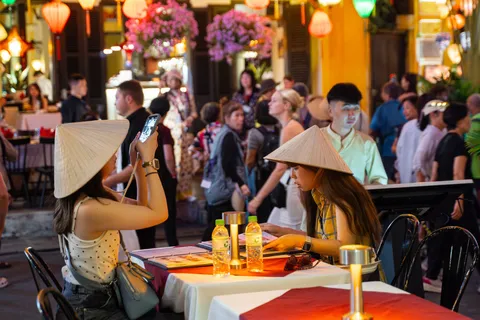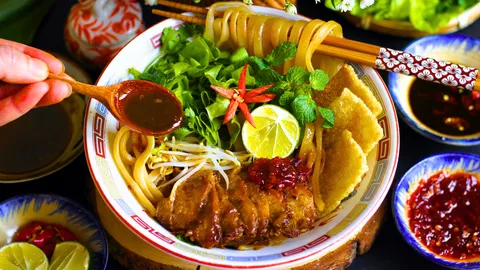HOI AN CENTRAL MARKET COMPLETE GUIDE
The Hoi An Market is the oldest and most significant market in Hoi An. Over the centuries, it has remained the largest market in town, even as the town has expanded considerably. The buying and selling activities here are still vibrant and bustling.
The Hoi An Market is the oldest and most significant market in Hoi An. Over the centuries, it has remained the largest market in town, even as the town has expanded considerably. The buying and selling activities here are still vibrant and bustling.
Visiting the Hoi An Market is a fascinating experience. As the largest traditional market, visitors will encounter the widest variety of local products here. This includes fresh vegetables, fruits, fish, animals, food, spices, tools, handicrafts, and more, many of which are unique and never seen before. These products come from various parts of the region and are sold by vendors wearing conical hats. In truth, at the Hoi An Central Market, visitors will see aspects of local life that are least influenced by tourism. Women carrying shoulder poles are also a favorite subject for photographers. People enjoy mimicking them and taking fun pictures.
History of the Hoi An Market
The history of the Hoi An Market is closely intertwined with the history of Hoi An, one of Southeast Asia's busiest trading towns. From the 15th to the 19th centuries, merchants from many countries, including China, Japan, the Netherlands, England, Portugal, and France, came here to trade. This influx of international trade made Hoi An a prosperous town. Many foreigners even migrated to Hoi An for living, business, and marriage, seeing it as their second home.
Before 1841, the Hoi An Market was located at the site of the current Elephant Temple (27 Le Loi Street). Later, the local residents moved it to its present location, which was owned by Ms. Ngo Thi Lanh, in front of the Quan Cong Temple. The tomb of a monk had to be relocated to build this important facility. The new market location was more convenient for trading activities due to its proximity to the main river, the Thu Bon River, and other waterways and islands in the area.
During the French colonial period, the original Hoi An Market was restored. Although it suffered damage during wartime, it was demolished and rebuilt in the early 2000s with the same size and design. Up to the present, there have been no significant changes. The market's roof is still covered by tiles, and its doors still open to the river and major streets of the town. Notably, local vendors continue to gather here to sell local products, keeping the market vibrant. This lively atmosphere is the soul of the Hoi An Market. Thanks to these characteristics, visitors can experience a "well-preserved" market today.
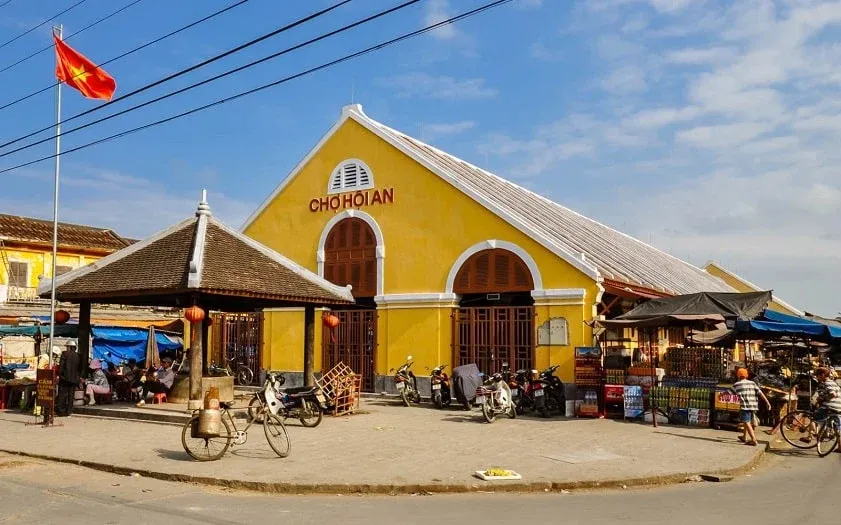
Different Sections of the Hoi An Central Market
From the entrance on Tran Phu Street, marked by a fresh-water well, visitors just need to walk straight through to see the interior of the Hoi An Market. It has four major sections in sequence: prepared foods, spices and cooking utensils, fresh meats and vegetables, and fish. The end of the market leads to the Thu Bon River.
The first section houses many food stalls along the main lane and by the side doors opening to the outside. Inside the cabinets, visitors will see various Vietnamese and Hoi An local dishes beautifully presented on plates. They look clean and delicious. Detailed information about eating in the Hoi An Market can be found in the dedicated paragraph below.
At the end of the first hall and the beginning of the second hall, visitors will encounter a variety of spices and cooking utensils. Nowhere else in town offers a more abundant collection. Here, vendors invite passersby to buy something, but they do so politely.
Before seeing the sun again, visitors walk through the section for fresh meat, which can be quite smelly. To see vendors at work, morning is the best time. Later in the day, there's not much to see here, as locals believe meat is no longer fresh if bought in the afternoon or evening.
Vegetables, herbs, and fruits are just outside, by the side of the streets. Among these products, visitors from other countries might not recognize many of them. They can buy and taste these items. Because the buyers are mainly locals, the names and prices of the products aren't displayed on signs, which can be a bit inconvenient for foreigners. In one corner, people dry cao lau noodles and squared crackers as toppings for a few local dishes.
By the river is the section for fresh fish and seafood. It's the wettest part of the Hoi An Market. We recommend coming here early in the morning to see the widest variety of products.
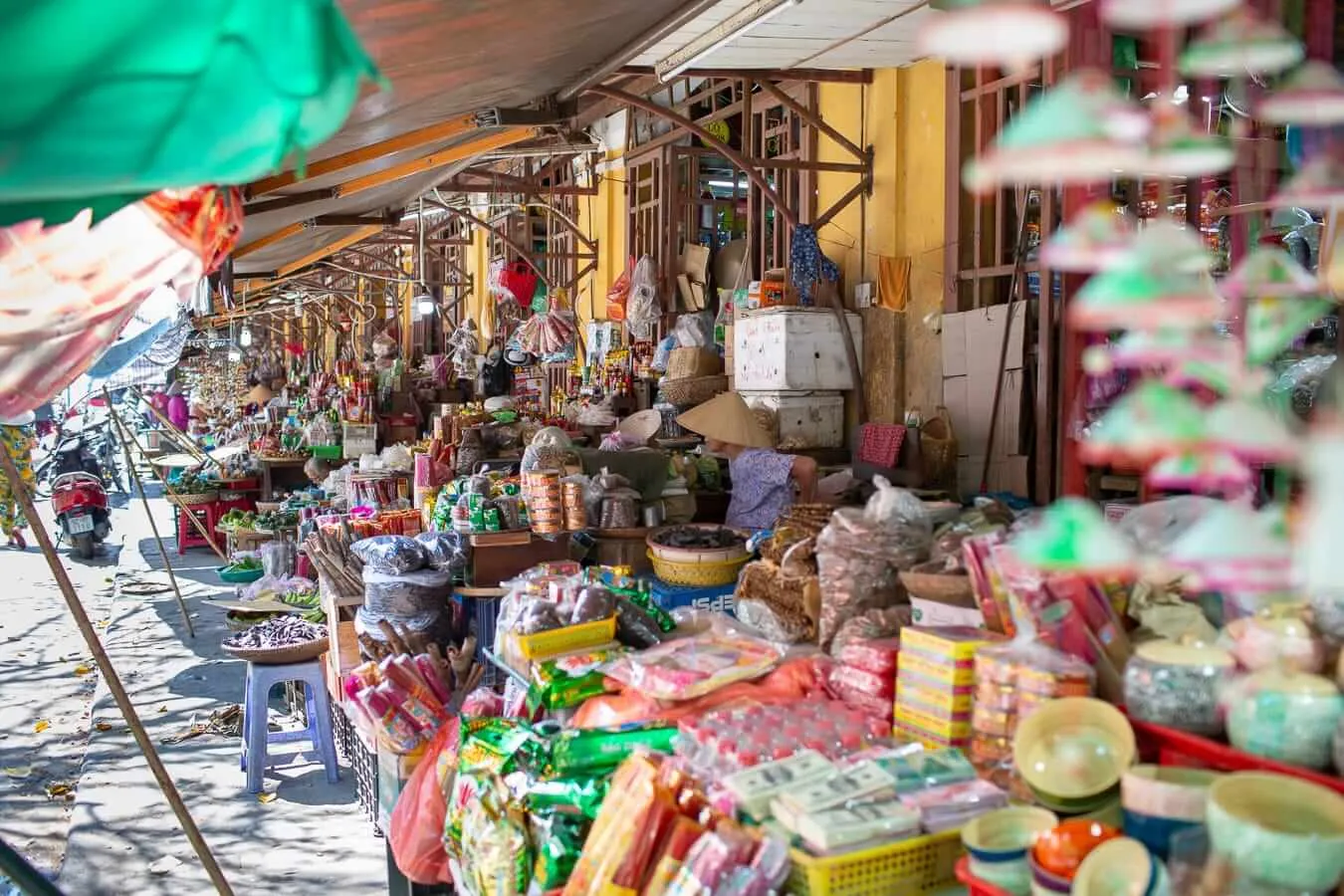
Opening Hours of the Hoi An Market
The Hoi An Market opens from early morning until evening every day. Travelers should visit from 9 am to 6 pm. The busiest times of the day are from 6 to 8 am, before local working hours, and from 4 to 5:30 pm, after local working hours. The market occasionally closes due to typhoons or floods caused by heavy rains during the wet season (from October to December).
Around sunrise, locals go to the Hoi An Market to sell vegetables, flowers, fruits, fish, meat, and prepared foods. Others come here to buy items because they believe these are the freshest at this time. As the central market (or the biggest market), sellers from distant markets also visit to look for good quality or cheap wholesale products. By the river, fishermen from the sea dock and offload the seafood they've caught. Thanks to this vibrancy and diversity, many photographers want to be early birds to capture great shots of Vietnamese real life. We recommend exploring the further fish markets. There, the variety of fish is richer, and it seems there are no tourists at all.
In the evening, only a few sellers remain in the Hoi An Market. They mainly sell food to people working in town or to late tourists.
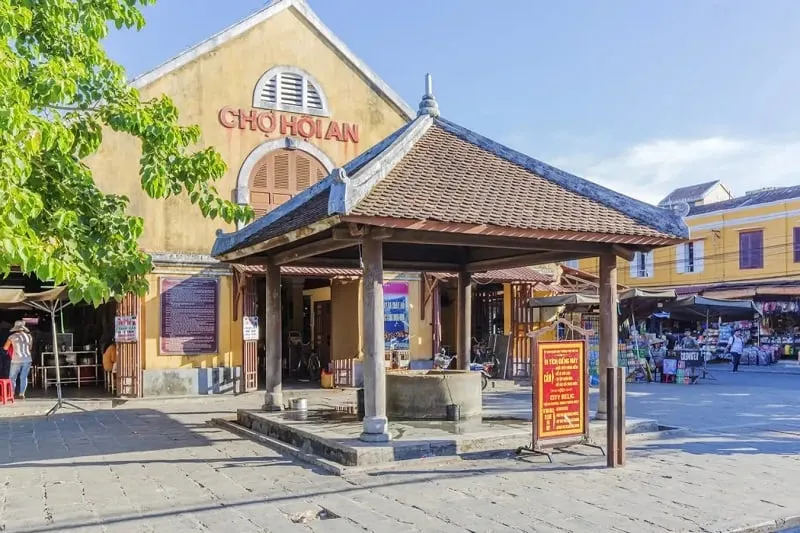
Eat in the Hoi An Central Market
The first section of Hoi An Market is dedicated to food and beverages. Before becoming popular among tourists, local people used to come here to eat and drink. Nowadays, they still do, although it's not as bustling as before. The food court continues to serve lunch for locals with various options (to eat with sticky rice).
Food stalls are arranged along the main aisle in the market, opening towards Tran Phu Street. Each stall has a well-lit, clean display cabinet of food options of appropriate size. Behind the counter, the seller prepares everything. Visitors can see the price board on the wall or the menu on the table, available in English.
In general, the food collection isn't extensive at Hoi An Market. However, all of Hoi An's famous local dishes are available here for tourists to try. You can find Cao Lau noodles, Mi Quang noodles, White Rose dumplings, Clear dumplings, Fried wontons, Chicken rice, Banh Mi sandwiches, fresh and fried spring rolls, Banh Xeo pancakes, Banh Beo rice cakes, and more. Diners sit on long stainless steel chairs facing inward, and utensils such as chopsticks, spoons, forks, and tissue paper are provided by the food vendors.
Interestingly, the food vendors do not sell water and beverages. Visitors either need to ask them for help or go to nearby stalls to purchase these items.
Note: The sellers here serve with a smile when visitors request a small portion (or even just a few pieces) on one plate. Of course, they are in business and expect to sell more. If their food is delicious, you might end up trying more samples.
The prices in the food courts of Hoi An Market are affordable. A full bowl of Cao Lau noodles costs around 40,000 VND. Similar prices apply to other noodle and rice dishes. Unlike many local food centers in the country, menus and food names are available in English, and prices are clearly displayed. No one is allowed to charge more.
In the late afternoon, local vendors come to Hoi An Market to sell street food, but outside the main market area. Near the well or Quan Cong temple, they grill delicious pork skewers (to wrap in rice paper with fresh rice paper and raw vegetables). Bo la lot, beef wrapped in betel leaf, is also available. Diners sit on low stools, and grills and side items are placed on a tray. Naturally, no forks or knives are provided. It's a fun way to try genuine local food and observe the world. Food tours in the city often select areas around Hoi An Market to introduce local dishes.
The list of street foods also includes grilled rice paper (bánh tráng nướng), sweet soups (chè, often for dessert), banana crepes, Banh Mi sandwiches, noodles, and locally-sourced fruits.
Banh Mi Phuong is a famous banh mi sandwich shop in Hoi An. Today, many tourists want to visit this place to taste "the best banh mi in the world." Anthony Bourdain, a renowned American chef, praised it on his show, No Reservations. The current location (2B Phan Chu Trinh Street) is not where he tried it; he visited Hoi An Market and went to Phuong's stall.
As mentioned earlier, the original Banh Mi Phuong is located at Hoi An Market. To find it, travelers need to walk to Tieu La Street, near Quan Cong temple. There's a sign with the name and an image of Anthony Bourdain eating there to recognize the exact spot. This shop is small, with only two tables. Today, it's owned and operated by Phuong's sister, who continues to use her original recipe. If you want to avoid long queues or crowds, visiting here is a smart choice.
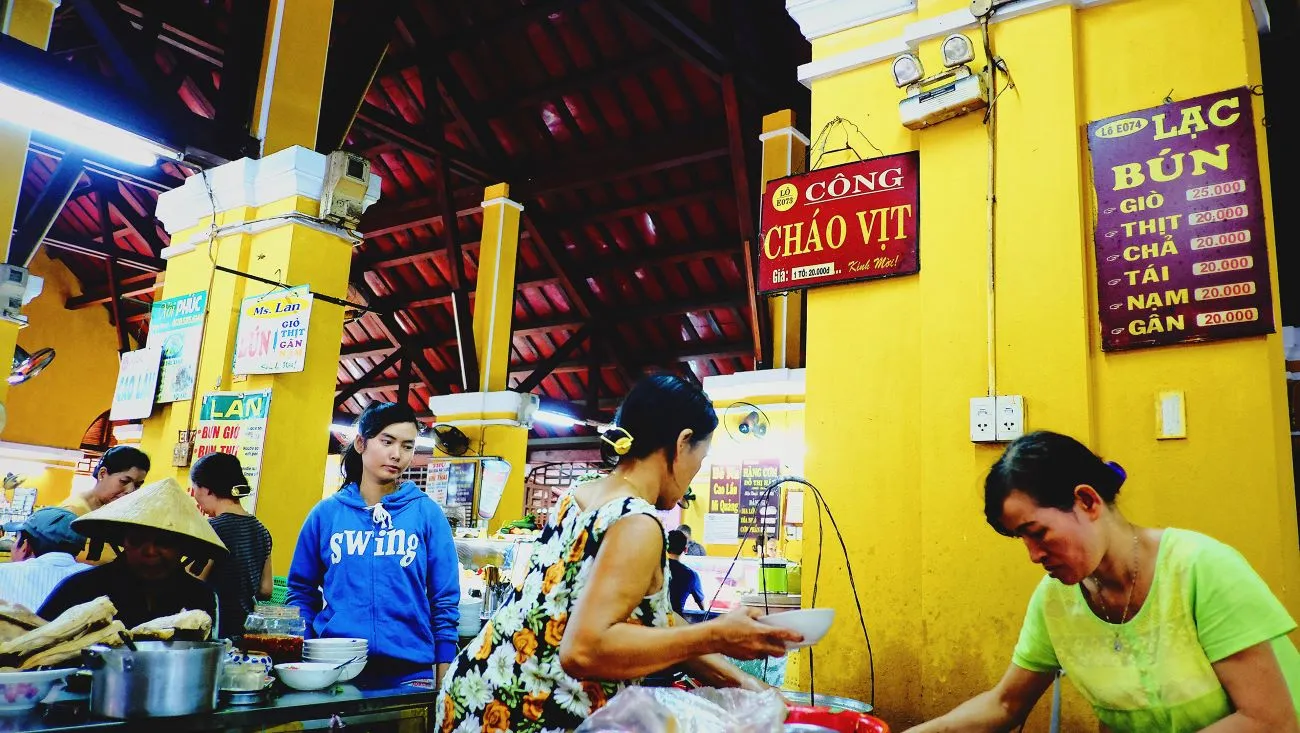
What to Buy in the Hoi An Market and Prices
Note: To buy things to wear (fabric, clothings, shoes, etc), travelers have to go to the Hoi An Fabric Market. It’s just a short walk from the Hoi An Central Market.
During past centuries, the Hoi An Market was a bustling trading place between local people and foreign merchants. Today, trading activities are still alive and active here. Tourists will see a variety of handicraft products and fresh products that are locally originated. Vietnamese have a “bargaining culture”, so it’s possible to make the first price go down a bit. Because not so many visitors come to the market for shopping now, shoppers are recommended to not . If can’t feel it’s affordable, let’s try it in other shops and stores.
Inside the market hall, vendors sell utensils used for cooking and souvenirs. They probably say hello and introduce something to passersby, like magnets, chopsticks or manual graters.
Outside the Hoi An Market, fresh produce is for sale. Almost everything is by kilogram but sometimes, sellers provide a pack, a bunch or a piece. The price depends on the season (the fact that tourists may hear a higher rate than locals). During the hot season, products are more diverse when the weather supports farming. Therefore, it’s the best time to taste fruits in Hoi An. These are produces seen in the market:
– Vegetables and flowers: cucumber, morning glory, beans, kumquat, bamboo shoot, beetroot, carrot, bell pepper, bitter melon, winter melon, gourd, tomato, lime, chilli, ginger, spinach, choy sum, and more.
– Fruits: papaya, trái mít (jackfruit), orange, pear, pomegranate, banana, mango, trái sầu riêng (durian), trái măng cụt (mango steen), trái thanh long (dragon fruit), trái chanh dây (passion fruit), apple, grape, trái bưởi (pomelo), pineapple, dưa hấu (watermelon), sugarcane, sweet corn, trái chôm chôm (rambutan), trái vải (lychee), trái nhãn (longan), trái vú sữa (star apple), trái mận (water apple), trái na (custard apple), trái ổi (guava), trái hồng xiêm (sapodilla), trái cóc (ambarella fruit), trái gấc (native red horned melon), and more.– Herbs: lemongrass, mint, rau răm (peppermint), sweet basil, lemon basil, perilla, coriander, lettuce, cilantro, fish leaf, rice paddy herb, lolot leaf and more.
– Other products: noodles, tofu, rice cakes, fish sauces and more.
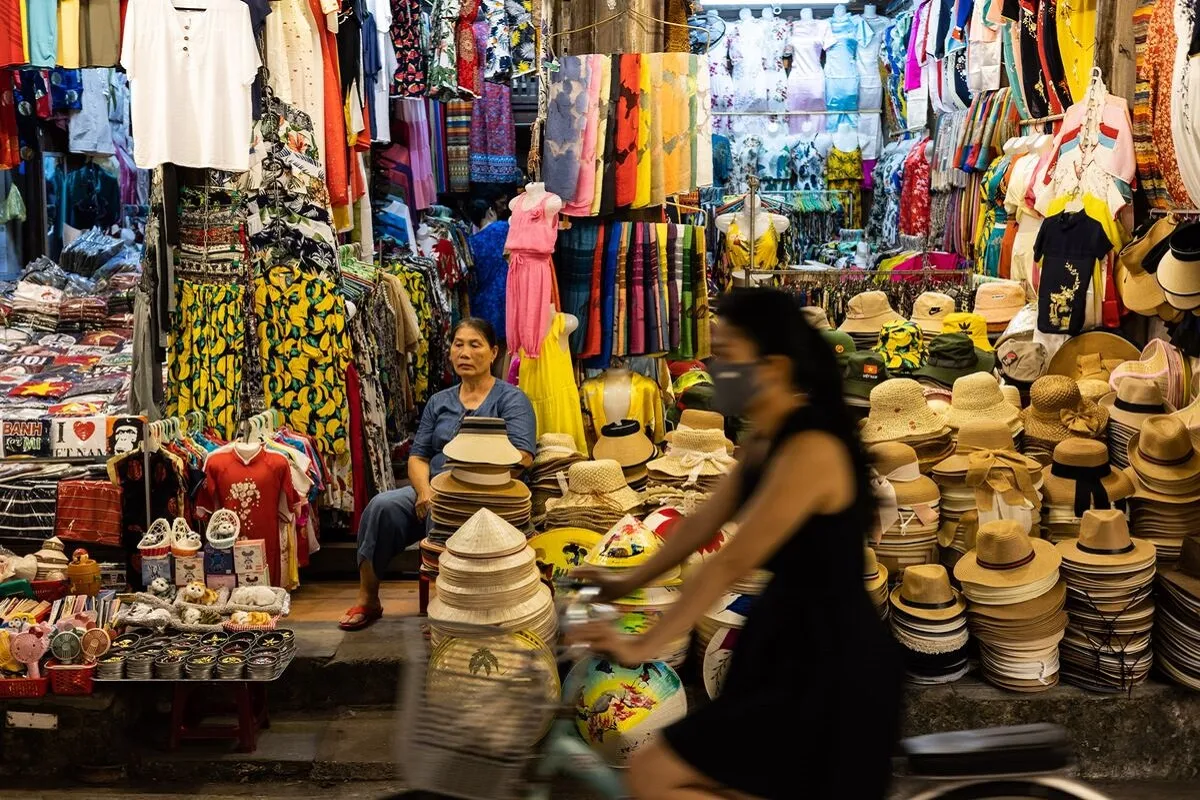
Reference article source: Central Vietnam guide
Thanks for reading!!!
